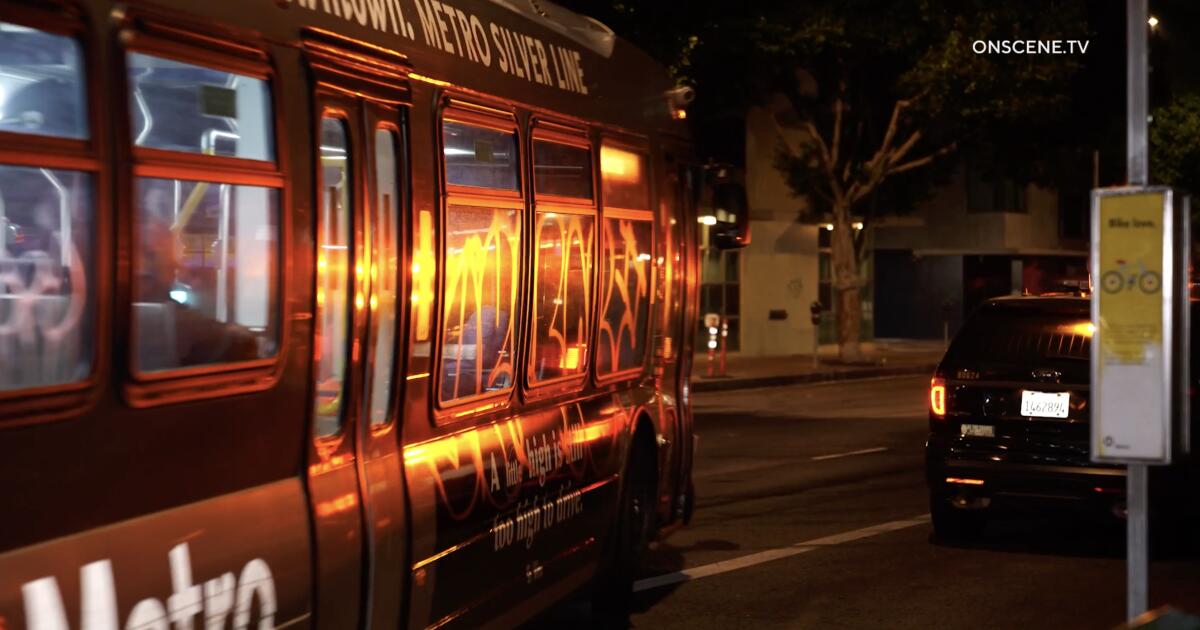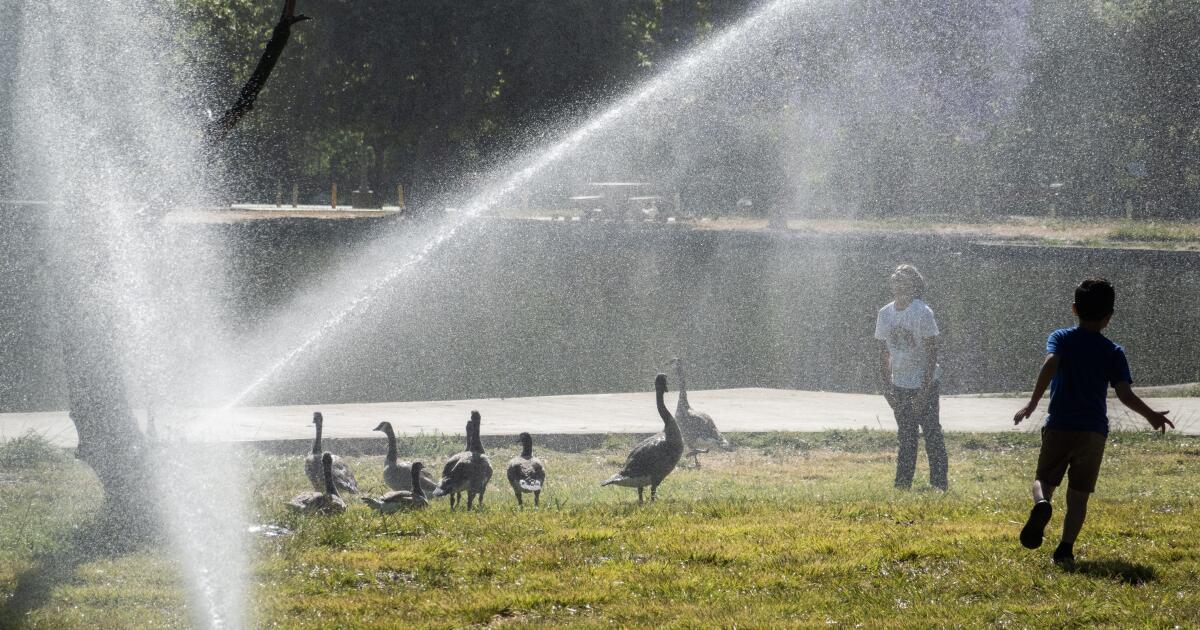World News
How much worse will extreme heat get in U.S. by 2050?

The next quarter of a century will bring considerable climate danger to millions of Americans living in disadvantaged communities, who will not only experience increased exposure to life-threatening extreme heat but also greater hardships from reduced energy reliability, a new nationwide report has found.
The report, published Wednesday by the ICF Climate Center, examines global warming projections in Justice40 communities — those identified by the federal government as marginalized, underserved and overburdened by pollution. The Justice40 Initiative was established under President Biden’s strategy to tackle the climate crisis, which aims to funnel 40% of benefits from certain federal climate, energy and housing investments into these communities.
But the report outlines a stark future for residents in these areas, including many in California.
Under a moderate-emissions scenario — one in which current fossil fuel consumption peaks in the coming decades and then starts to decline — at least 25 million people in disadvantaged communities will be exposed to health-threatening extreme heat annually by 2050, the report found.
Under a high-emissions scenario, reflecting unchanged “business as usual” greenhouse gas emissions, that number soars to 53 million people. Extreme heat is defined as at least 48 health-threatening heat days per year.
“We were a bit surprised at those numbers — they’re large and meaningful,” said Mason Fried, one of the report’s authors and the director of climate science at ICF, a global consulting firm. “The potential exposure of extreme heat does seem to fall disproportionately on disadvantaged communities.”
The report also notes that about 8 million people in Justice40 communities are already exposed to heat waves that can affect their energy systems, including triggering power outages. But by 2050, that number could rise to 34 million under a moderate-emissions scenario and 43 million under a high-emissions scenario.
It isn’t only disadvantaged communities that will experience the worsening effects of extreme heat, which is one of the deadliest and most widespread climate risks.
Under a moderate-emissions scenario — the most likely one — 41 million Americans outside of Justice40 communities will also be exposed to 48 or more health-threatening heat days by 2050, and 44 million will experience energy-impacting heat, the report found.
The effects will not be equal, however. Many marginalized communities are already at a disadvantage when it comes to extreme heat for a variety of reasons, including the population’s average age and preexisting health conditions such as diabetes and heart disease, which can be exacerbated by heat.
Lack of tree canopy, lack of air conditioning at home or work and inefficient infrastructure can also play a part, said V. Kelly Turner, an associate director of urban planning at UCLA who did not work on the report.
“Everybody’s going to be exposed to more heat, so is the question really, how much more exposed? Or is the question, how many people are living with inadequate infrastructure to keep them safe when it is hot?” said Turner, who also co-directs the UCLA Luskin Center for Innovation.
In places like Los Angeles, temperatures can vary by several degrees between neighboring areas just because of differences in vegetation, asphalt and the built environment.
Even still, many Angelenos are better acclimated to higher temperatures than people in cooler parts of the state or country, Turner said.
“It’s about what you’re used to versus what you’re exposed to,” she said.
That’s why the report’s findings about energy impacts are particularly worrisome.
“It’s those northern latitude communities where this might become particularly difficult if the energy grid fails,” she said. “In Northern California [and places] where you aren’t thinking about heat all the time, that’s where maybe you’re not prepared as much.”
Indeed, the report’s projections show an intensification of potential exposure not only in traditionally hot areas, but in regions that historically have not experienced very high temperatures, such as the Northwest and Midwest. Fried referenced the 2021 Pacific Northwest heat dome, which caused more than 650 deaths in the U.S. and Canada.
“It’s a phase change,” he said. “It’s a fundamentally different kind of exposure, which could have outsize impacts in the future.”
In fact, the report shows, most of California will in some ways fare better than other parts of the country, such as Texas and the Southeast, which are expected to see some of the worst heat outcomes by 2050.
Only a smattering of Justice40 communities in the Golden State will see 48 or more health-threatening heat days under a moderate-emissions scenario, with additional communities appearing under a high-emissions scenario.
But the Central Valley and southeastern California light up like a summer fireworks show when it comes to energy-impacting heat days, the report shows — meaning many people in those areas could suffer from power outages and swelter without air conditioning or other forms of relief.
“It doesn’t take much, or a large increase in extreme heat, to get a tipping point there,” Fried said.

Increasing heat days could affect energy systems across the country by 2050, including in California. Projections are worse under a high-emissions scenario.
(ICF / ClimateSight)
The report outlines a number of high-level recommendations for policymakers, such as identifying at-risk communities and engaging stakeholders in the planning and preparation for these scenarios. It also points out that more federal funding is being made available to tackle extreme heat through Biden’s Inflation Reduction Act and Bipartisan Infrastructure Law.
Among those federal endeavors are two new national centers to support community heat monitoring and resilience, which were announced this week by the U.S. Department of Commerce and the National Oceanic and Atmospheric Administration.
One federal center will be based in Durham, N.C., and the other will be at UCLA and directed by Turner, who described it as “an all-hands-on-deck approach to learn from existing efforts to prevent the worst consequences of extreme heat.”
The center will work to get nonprofit organizations, cities, academic institutions and international and tribal communities into the same room to distill general and specific lessons and help determine the best paths forward, Turner said. It will also fund 10 communities over each of the next three years with the goal of providing recommendations to the federal government about how best to “support local communities as they transition to a more heat-resilient future.”
Turner said California and Los Angeles are doing a good job, but should look beyond efforts such as urban tree canopy improvements and cool roof and pavement installations. There is more to do, including deeper analysis of heat exposure in specific locales and regulations that can have an effect.
Her recommendations include rethinking how the Federal Emergency Management System evaluates heat risk and property damage; ensuring that vulnerable communities have the technical support they need to apply for grants and secure funding; creating low-income housing energy assistance programs; and passing legislation to provide cooling to all residents, Turner said.
She pointed to California’s plan to establish the first statewide ranking system for heat waves as a positive example, as well as new heat monitoring tools from NOAA and the U.S. Centers for Disease Control and Prevention.
The ICF report comes at a moment when heat records are continually being broken around the globe, with 2023 going down as the planet’s hottest year on record.
What’s more, the 2050 projections are for a “typical year,” but Fried said recent experience has shown many years can be atypical due to El Niño or other effects that can make them far warmer, with even worse potential outcomes.
That’s why it’s not only important to help vulnerable populations prepare for a warmer future, but also to continue pushing to reduce reliance on fossil fuels and other sources of planet-warming emissions that are driving the scenarios depicted in the report, he said.
“If we take steps to mitigate emissions, we can do better than what’s pictured here,” he said.
World News
China’s BYD posts 21% jump in quarterly EV sales, closes gap with Tesla
BEIJING (Reuters) – China’s BYD (BYDDY) posted a 21% rise in second-quarter electric vehicle sales, closing the gap with Tesla (TSLA) after handing back the world’s top EV vendor title to the U.S. rival in the first quarter.
BYD sold 426,039 EVs in the April-June quarter, according to Reuters’ calculations based on its monthly sales reports. That’s around 12,000 vehicles fewer than Tesla’s vehicle deliveries estimated for the second quarter.


Tesla is expected to report a 6% drop in April-June quarter vehicle deliveries on Tuesday, the first time the U.S. firm is set to post two straight quarters of decline, as it deals with stiff competition in China and slow demand due to a lack of affordable new models.
The company may again cede its EV championship to BYD if the actual results turn out to be softer than estimated, with Barclays predicting an 11% drop in second-quarter deliveries, Tesla’s biggest ever.
Tesla has hit a speed bump after years of rapid growth that helped make it the world’s most valuable automaker. It warned in January that deliveries growth in 2024 would be “notably lower” as a boost from months-long price cuts wanes.
The EV maker has cut output of its best-selling Model Y electric car by a double-digit percentage number at its Shanghai plant since March to address weakening demand for its aged models in China, its second-largest market after the United States, Reuters reported in May.
By comparison, its top Chinese competitor BYD maintained steady growth in EV sales, while EV upstarts such as Nio reported stellar growth last quarter. NIO’s vehicle deliveries in the second quarter more than doubled to 57,300 units.
Price cuts and a growing shift in consumer demand to EVs and hybrids from gasoline-powered vehicles are the main reasons behind Chinese EV makers’ strong sales in recent months, said Cui Dongshu, secretary general, China Passenger Car Association (CPCA).
Sales of new energy vehicles including EVs and plug-in hybrids in China made up 46.7% of total car sales in May, a fresh monthly high, as per CPCA data.
(Reporting by Qiaoyi Li, Zhang Yan and Kevin Krolicki; Editing by Miyoung Kim and Sherry Jacob-Phillips)
World News
Biden slams SCOTUS presidential immunity ruling, ignores questions about dropping out

President Biden slammed the Supreme Court’s ruling on presidential immunity in Trump v. United States, saying it means there are virtually no limits on what a president can do, in a speedy address Monday evening.
The president spoke for less than five minutes – four minutes and 40 seconds to be exact – before turning his back to the press and walking away.
“This is a fundamentally new principle, and it’s a dangerous precedent, because the power of the office will no longer be constrained by the law, even including the Supreme Court of the United States,” Biden said.
The Supreme Court ruled that a former president has substantial immunity from prosecution for official acts committed while in office, but not for unofficial acts.
TRUMP IMMUNITY CASE: SUPREME COURT RULES EX-PRESIDENTS HAVE SUBSTANTIAL PROTECTION FROM PROSECUTION

Trump and Biden squared off in their high-stakes 2024 election debate rematch last week. (Justin Sullivan/Getty Images, left, )
In a 6-3 decision, the Court sent the matter back down to a lower court, as the justices did not apply the ruling to whether or not former President Trump is immune from prosecution regarding actions related to efforts to overturn the results of the 2020 election.
Biden continued his address, saying that the American people must decide whether Donald Trump’s assault on democracy on January 6th makes him “unfit” for public office and the highest office in the land.
“The American people must decide if Trump’s embrace of violence to preserve his power is acceptable. Perhaps most importantly, the American people must decide if they want to entrust the presidency to Donald Trump once again. Now knowing, he’ll be even more emboldened to do whatever he pleases, whenever he wants to do it,” Biden said.
Biden also spoke about the character of the nation’s first president, George Washington, and how he believed power was limited, not absolute.
Biden wrapped his speech and dodged questions from reporters as he left abruptly.
Reporters shouted questions at Biden, asking him if he plans to drop out of the presidential race following his debate with Trump.

US President Joe Biden speaks during a Memorial Day address at Arlington National Cemetery in Arlington, Virginia, US, on Monday, May 27, 2024. (Bonnie Cash/UPI/Bloomberg via Getty Images)
Biden has not taken questions from the press and has used teleprompters at his events, including a fundraiser in the Hamptons, following his disastrous debate performance against Trump last week.
“Today’s Historic Decision by the Supreme Court should end all of Crooked Joe Biden’s Witch Hunts against me, including the New York Hoaxes – The Manhattan SCAM cooked up by Soros backed D.A., Alvin Bragg, Racist New York Attorney General Tish James’ shameless ATTACK on the amazing business that I have built, and the FAKE Bergdorf’s “case.” PROUD TO BE AN AMERICAN!,” Trump wrote in a post on his social media site Truth Social.
BIDEN CAMP DISMISSES TRUMP IMMUNITY RULING: ‘DOESN’T CHANGE THE FACTS’

Trump pleaded not guilty to all charges and argued he should be immune from prosecution from official acts done as president of the U.S. (Michael M. Santiago/Getty Images)
The former president was charged in August 2023 by Special Counsel Jack Smith with conspiring to overturn the results of his election loss to President Biden in the run-up to the Jan. 6, 2021, riot at the U.S. Capitol.
Trump has denied doing anything wrong and has said this prosecution and three others are politically motivated to try to keep him from returning to the White House.
Trump shared his reaction to the Supreme Court’s ruling on his presidential immunity case, saying it’s a “big win for our constitution and democracy,” according to his Truth Social page.
CLICK HERE TO GET THE FOX NEWS APP
“THE SUPREME COURT DECISION IS A MUCH MORE POWERFUL ONE THAN SOME HAD EXPECTED IT TO BE. IT IS BRILLIANTLY WRITTEN AND WISE, AND CLEARS THE STENCH FROM THE BIDEN TRIALS AND HOAXES, ALL OF THEM, THAT HAVE BEEN USED AS AN UNFAIR ATTACK ON CROOKED JOE BIDEN’S POLITICAL OPPONENT, ME. MANY OF THESE FAKE CASES WILL NOW DISAPPEAR, OR WITHER INTO OBSCURITY. GOD BLESS AMERICA!” Trump posted.
Fox News Digital’s Brooke Singman and Brianna Herlihy contributed to this report.
World News
Hurricane Beryl Flattens Grenada’s Carriacou Island

Officials in Barbados said on Monday that the island had been spared the worst of Beryl.
The prime minister of Barbados, Mia Mottley, told a nationwide broadcast from the island’s emergency operations center that as many as 20 fishing boats, including two popular cruisers, had possibly sunk. Still, she added, “This could have been far worse for us.”
Roughly 40 homes were known to have sustained roof or structural damage so far, she said, though that number was expected to rise as more than 400 residents returned home from shelters.
On St. Lucia, storm surge caused significant damage to fishing vessels, sinking at least 20 boats, according to initial reports. Dozens of homes were also damaged.
People across the eastern Caribbean had started preparing for the storm over the weekend, including those doing some last-minute shopping for supplies.
“Hurricanes are not something that we take lightly at home as a family,” said Fleur Mathurin, who lives on St. Lucia, where some parts of the island were experiencing power outages. “Having my family, my grandmothers, great-grands, gone through Hurricane Allen and Gilbert, this is something that they always preach to us.”
As of Monday afternoon, the storm was expected to continue tearing its way through the Caribbean, reaching Jamaica with potential hurricane conditions by Wednesday according to the National Hurricane Center.
Julius Gittens contributed reporting from Christ Church, Barbados; Linda Straker from Gouyave, Grenada; Kenton X. Chance from Kingstown, St. Vincent; Sharefil Gaillard from Gros Islet, St. Lucia; and Maria Abi-Habib from Mexico City.
-

 African History5 years ago
African History5 years agoA Closer Look: Afro-Mexicans 🇲🇽
-

 African History5 months ago
African History5 months agoBlack History Facts I had to Learn on My Own pt.6 📜
-

 African History5 years ago
African History5 years agoA Closer Look: Afro-Mexicans 🇲🇽
-

 African History1 year ago
African History1 year agoMajor African Tribes taken away during the Atlantic Slave Trade🌍 #slavetrade #africanamericanhistory
-

 African History1 year ago
African History1 year agoCameroon 🇨🇲 World Cup History (1962-2022) #football #realmadrid #shorts
-

 African History1 year ago
African History1 year agoPROOF AFRICAN AMERICANS AIN'T FROM AFRICA DOCUMENTED EVIDENCE
-

 African History5 months ago
African History5 months agoBlack History Inventors: Mary Kenner 🩸
-

 African History5 months ago
African History5 months agoMr Incredible Becoming Canny/Uncanny Mapping (You live in Paraguay 🇵🇾)































